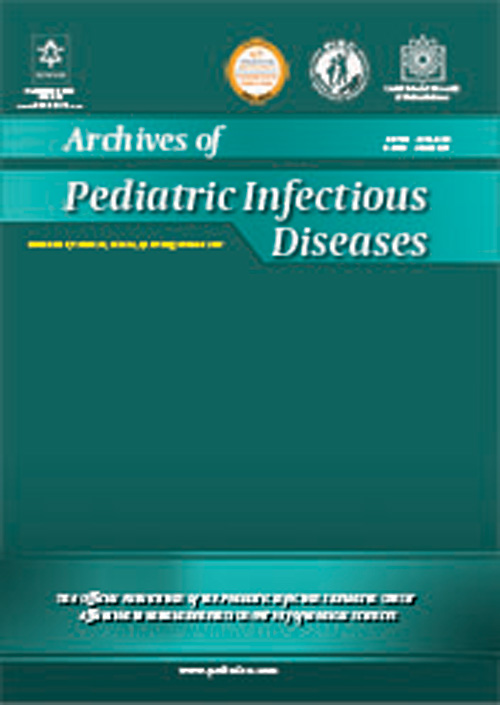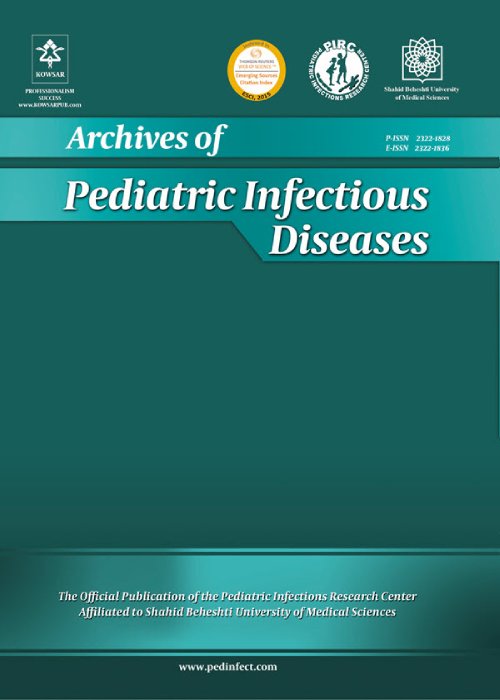فهرست مطالب

Archives of Pediatric Infectious Diseases
Volume:7 Issue: 3, Jul 2019
- تاریخ انتشار: 1398/05/15
- تعداد عناوین: 8
-
-
Page 1BackgroundIntegron is an important element in creating multi-drug resistant (MDR) bacteria. This study evaluated the relationship of class I integron and antibiotic resistance in extended-spectrum beta-lactamase producing (ESBL) isolates of Escherichia coli (E. coli).MethodsA total of 66 ESBL-producing E. coli were isolated from urinary tract infection in Kermanshah and their antimicrobial susceptibility was assessed. The incidence of class I integron was determined in isolates using PCR. The class I integron-associated gene cassettes were also verified by DNA sequencing. Data were analyzed using statistical methods.ResultsOf 66 ESBL-producing isolates, 65 (98.5%) were MDR. The most prevalent antibiotic resistance of the isolates was observed for ampicillin (98.4%), ceftriaxone (98.4%), cefotaxime (95.4%), and co-trimoxazole (86.3%). The frequency of class I integron in isolates was 92.3%. The relationship between class I integron and resistance to streptomycin, co-trimoxazole, and ceftazidime was statistically significant. The genes encoding resistance to streptomycin and co-trimoxazole, as well as a gene encoding a protein with unknown function, were associated with class I integron. The most common gene cassette was dfrA17-aadA5.ConclusionsThe results indicate a high prevalence of antibiotic resistance among ESBL-producing isolates to the antibiotics commonly used for the empirical treatment of urinary tract infections. The frequency of class I integron and associated gene cassettes involving resistance to antibiotics is high. There is a high percentage of MDR among the ESBL-producing isolates, which mostly contain gene cassettes. These findings suggest a strong association of integron and ESBL genes in the isolates.Keywords: Integrons, Gene Cassettes, Escherichia coli, Multidrug Resistance
-
Page 2BackgroundMeasles is one of the leading causes of childhood morbidity and mortality in the world despite the availability of a relatively inexpensive, safe, and effective vaccine.ObjectivesThe study aimed to evaluate measles vaccine effectiveness as one of the fundamental actions to eliminate measles infection. The specific objectives were to estimate the measles vaccine effectiveness at the level of under 12-year-old children population using the Egyptian surveillance data for cases seeking medical care at Embaba Fever Hospital between March 2017 and February 2018 and to determine the trend of measles virus infection during the same period.MethodsThis hospital-based cross-sectional analytical study was conducted at Embaba Fever Hospital in Giza Governorate for the evaluation of measles vaccine effectiveness. In total, 466 patients were enrolled in the study and investigated clinically and laboratory to confirm the diagnosis of measles.ResultsOf the 466 children, 69 (14.8%) tested positive for measles IgM antibodies. Children in the 1 - 4 year age group had the highest positivity rate to measles antibodies (43.5%), followed by the age group of ≥ 5 years (29%) and the age group of < 1 year (27.5%). The overall estimated vaccine effectiveness was 80.7% (95% CI: 63.7 - 90.8%) for the one-dose measles-mumps-rubella (MMR) and 91.8% (95% CI: 88.0 - 94.5%) for the two-dose vaccine.ConclusionsMeasles infection is still high among vaccinated and unvaccinated children in Egypt. Therefore, it is suggested that a sustainable plan be developed for achieving high vaccination coverage among children younger than five years of age.Keywords: Measles Infection, Vaccine Effectiveness, Fever
-
Page 3BackgroundBacterial resistance is considered an important concern in health care medicine. There is a close relationship between the use of antibiotics and drug resistance.ObjectivesIn this study, pediatricians’ views and their practices regarding parents’ request for prescribing antibiotics when they did not see the need for the prescription and their opinions and suggestions were studied.MethodsThis study was a qualitative cross-sectional interviewer assist study of pediatricians using a validated self-designed questionnaire. The study population included one hundred pediatricians in Tehran province from January to May 2018. Sampling method was non-probability convenience method.ResultsThe mean age of the participants was 37.04 ± 5.9 years, 47% male, and 53% female. The frequency of parents’ requests from pediatricians to prescribe antibiotics was 53% and about 45.3% of them agreed with this request. Gender was significant in participants’ agreement with the request of parents (60% in male and 26% in female). The important issues of this agreement were: the absence of a definitive clinical diagnosis (51%); when the initial treatment was not effective (39%); and concerned about legal consequences (51%). About 54.7% did not agree with this request. The most important issues of disagreement were: confirmation of clinical diagnosis (79%), and when pediatricians did not feel pressure from the parents (73%). The most important recommendation by the participants to reduce parents’ request included an adequate explanation and counseling with parents at the time of the visit (70%), increasing parental information in the community (62%), and the standardized guidelines for the treatment of diseases (51%).ConclusionsBased on the results, consultation with parents reduces parental concern and pressure. The parental information still plays a major role in the proper use of antibiotics. Retraining pediatricians and preparation of guidelines can be effective in increasing their confidence and correct diagnosis and prescribing decisions.Keywords: Antibiotic, Drug Resistance, Parents Request, Pediatricians
-
Page 4BackgroundHemophagocytic lymphohistiocytosis (HLH) is a disorder of the immune regulatory system with a high rate of mortality. The clinical presentation of HLH could be similar to those of many other conditions, making its diagnosis difficult.MethodsThe current study was conducted on the children with HLH referred to the Pediatric Ward of Imam Reza Hospital, Mashhad, Iran during nine years from 2010 to 2018. The data collection tool included items on clinical presentations, physical examination, laboratory data, treatment strategy, and the disease outcome. The diagnosis of HLH was made based on the HLH-2004 Diagnostic Criteria. Data were analyzed using SPSS version 20.ResultsAmong the 17 cases with HLH, the mean age at the onset of HLH was 4.671 ± 4.60 years with a male to female ratio of 11:6. Fever and splenomegaly were the most common findings. The study of the etiology revealed that about 30% of the children had the familial form of HLH, 17.5% were previously diagnosed with rheumatologic disorders (i.e., systemic lupus erythematosus and systemic-onset juvenile idiopathic arthritis), and the same rate was affected by infectious diseases. Idiopathic factors, the Chediak-Higashi syndrome, and the Griscelli syndrome were responsible for the occurrence of HLH in 17.5%, 12%, and 6% of the cases, respectively. According to the obtained results of the study, 35.3% of the patients were cured and about 64.7% died.ConclusionsDue to the high risk of mortality from this disorder, the recognition of HLH symptoms, especially atypical presentations of the disorder, is critical both for pediatricians and subspecialists.Keywords: Hemophagocytic Lymphohistiocytosis, Immunosuppression, Mortality, Macrophage Activation Syndrome, Pediatrics
-
Page 5BackgroundGram-negative bacteria are a major cause of pulmonary infection in patients with cystic fibrosis (CF).ObjectivesThe study aimed to conduct the molecular identification of Gram-negative bacterial flora causing pulmonary infection in children with CF.MethodsIn this study, sputum samples were taken from 64 CF children undergoing treatment as outpatients or inpatients at a referral children’s hospital in Tehran. The PCR technique was used to detect the presence of Gram-negative bacteria, namely Pseudomonas spp., Acinetobacter baumannii, Stenotrophomonas maltophilia, and Burkholderia cepacia.ResultsAll samples were positive for 16srRNA. Pseudomonas spp. and A. baumannii were detected in 47% and 14% of the studied samples, respectively. Co-colonization by Pseudomonas spp. and A. baumannii was observed in three (5%) samples.ConclusionsAccording to this survey, Pseudomonas spp. were the most prevalent Gram-negative bacteria isolated from CF patients with pulmonary infection by molecular assays.Keywords: Pseudomonas, Cystic Fibrosis, Polymerase Chain Reaction
-
Page 6BackgroundAppendicitis is the inflammation of the appendix. In spite of advances in the diagnosis and management of acute appendicitis, its morbidity is still significant. Despite widespread use of ultrasonography, computed tomography (CT) scan, and laparoscopy to diagnose appendicitis, the rate of misdiagnosis is not diminished accordingly.MethodsThe current study aimed at determining the prevalence of primary misdiagnosis in pediatric patients presenting with appendicitis to Aliasghar Hospital, a tertiary referral center in Tehran, Iran from 2005 to 2015.ResultsIn the present study, the misdiagnosis rate of acute appendicitis was 7.4% in 10 years. Most causes of misdiagnosis were mesenteric adenitis, urinary tract infection, and gastroenteritis. Despite the availability of various diagnostic methods, the majority of patients with initial misdiagnosis were finally subjected to laparotomy for acute appendicitis. Ultrasound examination was useful in only 23% of the cases. Location of appendicitis in patients with initial misdiagnosis was retrocec in nine patients (53%), retroileum in five patients (29%), and pelvis in three patients (18%).ConclusionsCloser attention to signs and symptoms of acute appendicitis and higher clinical suspicion could reduce the rate of misdiagnosis and therefore minimize complications.Keywords: cute Appendicitis, Diagnosis, Complications, Misdiagnosis
-
Page 7Acute diarrhea is one of the most common complaints of children referred to pediatricians and the second cause of death in children under 5 years old. In these days, despite many advances in the treatment of diarrhea, delay in diagnosis and treating specific conditions can cause severe complications and prolong the duration of disease. The new algorithmic approach will reduce the medical errors (human errors) due to lack of attention to red flags and principles of treatment. In this new algorithmic approach, the alphabetics that make up the word “DIARHEA” been used to remember important points.Keywords: Acute Diarrhea, Algorithmic Approach, Diagnosis
-
Page 8Broncho-esophageal fistula (BEF) is a rare congenital anomaly affecting the respiratory and upper gastrointestinal tract. The rarity makes its timely diagnosis very challenging. This study presents a rare case of missed congenital BEF in a six-year-old girl with repaired esophageal atresia in the neonatal period suffering from recurrent respiratory symptoms, choking, and respiratory distress following eating, resulting in vomiting or regurgitation for three years before admission. While the contrast esophagography and endoscopy had failed to diagnose her problem, the methylene blue test via an esophageal catheter observed by fiberoptic bronchoscopy could detect the presence of BEF reliably in the present case. Presenting this case can raise physicians’ knowledge of the diagnostic role of methylene blue test via fiberoptic bronchoscopy.Keywords: Broncho-Esophageal Fistula, Aspiration Pneumonia, Esophageal Atresia, Child


